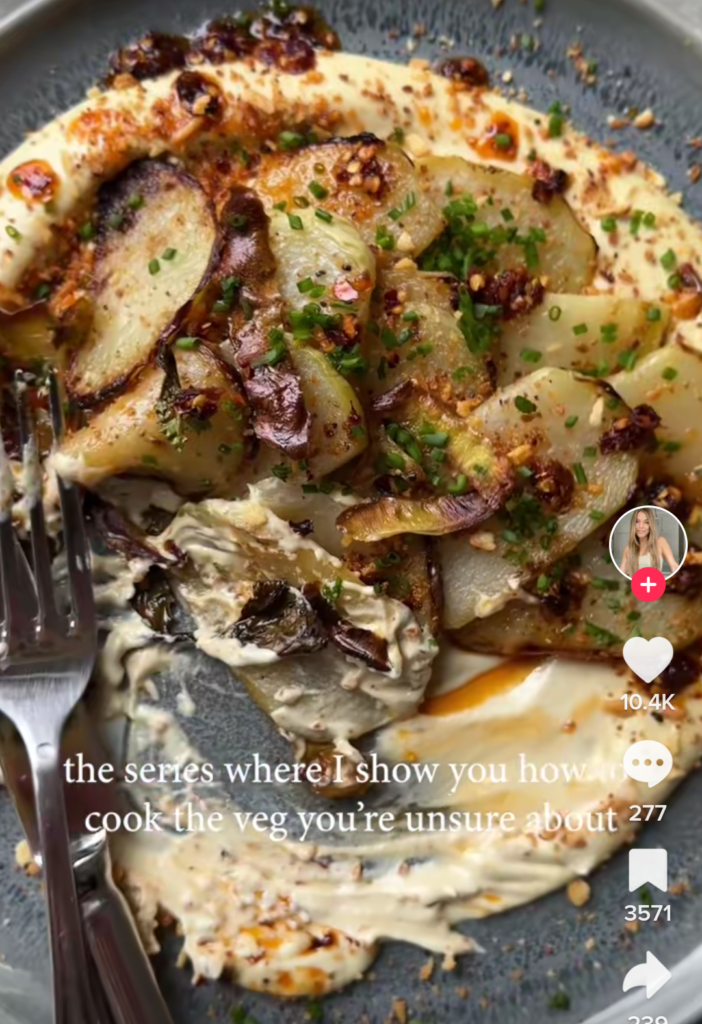
Took me zero minutes to find this recipe. (Credit: someone called ‘natalia’ on TikTok. Apologies, natalia.)
It has never been a better time to be a vegan. The world of vegan cooking has never been more exciting, more diverse, more creative. There are no limits when it comes to what fabulous dishes you can create!
Having said that, there are several extremely strict rules that you are legally obliged to adhere to when cooking vegan food online in 2023. I’m here to talk you through them so that no one has to make any silly mistakes and end up doing something dangerous or just looking like a cretin in front of everyone (not pointing any fingers here but you know what you did, Timothy).
1. You can title your recipe anything you want! Literally anything!
…As long as the recipe title begins with “This is my creamy…”. I’m afraid there’s no wiggle room on this one, team. You’re going to need to use this as the prefix for all of your recipes regardless of what you actually wanted to do. This still leaves you a lot of creative freedom to riff on whatever themes you like after that though! Here are some examples to get you started:
“This is my creamy butterbean mash with roasted parsnips.”
“This is my creamy pea and parmesan cloud with wiffled gemnuts and a za’atar glaze.”
“This is my creamy pumpkin linguine with oated scruncheons.”
Note: A variation on this template has been occasionally – and reluctantly – permitted in recent evaluations. The variation: “This is my ____ WITH creamy ____”.
2. Make sure there is a heap of goo at the bottom.
Listen gang, I don’t know what culinary school you went to, but it’s 2023 now and the gastronomic planets have aligned in such a way that no vegan recipe anywhere on earth can be considered complete without an extremely large swirl of something puréed underneath the other things on the plate. I’m talking generous here. You’re going to want to have a dollop of gloop an inch deep and as large as your face right there in the center of the plate. Then you can artfully scatter something gorgeous-looking on top to scoop up all that delicious goo. Some examples: roast potatoes on a slick of beetroot and walnut goo, crunchy tofu cubes on a slather of puréed cauliflower and tahini goo, vegan soy koftes on a swamp of CREAMY (see above) spinach and cashew goo. You could take this idea in all kinds of directions. Go(o) to town!
Don’t make the mistake of thinking this is a dip. With a dip, the ratio is usually around 1 cup of dip to 2-3 cups of dipping media (tortilla chips, carrot sticks, falafel patties etc). This is also not a sauce: we’re not applying a light coating to add a zing of flavour here. This is more like an incredibly stiff soup with large and interesting croutons; you want the ratio of goo to non-goo items to be around 1 litre of goo for every 5 chunky bits. You want there to be so much goo that there is no way in hell a person could eat all of it without resorting to just shoveling it neat off the plate with a spoon like a very savoury porridge.
Note: There are a few rare exceptions to rule 2. See rules 3 and 5.
3. There had better be something crispy that you can scrape your knife on, I swear to fucking god.
It is extremely important that you are able, at some point during the recipe, to crisp something up to the point that you can scrape your knife on it to show how crispy it is. I cannot stress this enough. Toast up a pita and scrape it; fry a piece of breaded tofu and scrape it; for god’s sake, if you can’t find anything else to get crispy and scrape with your knife just grill your dishtowel with a drizzle of olive oil and scrape it with your knife before you use it to wipe down the countertop.
Note: If the crispy knife-scrapey item is large enough, for example a whole ciabatta loaf, it is permitted to include the goo from rule 2 sandwiched inside the crispy item along with the other recipe elements, rather than heaping the goo onto a plate. This exception to the rule is only permitted if the following condition is observed: the finished product MUST be cut in half, squeezed slightly and pulled apart to show an outrageously decadent cross-section.
4. You must also include a topping.
Vegan food is not vegan food without a sprinkle of unidentifiable brown rubble on top. There are thousands of different potential toppings: something granola-ish, crispy fried bitty-bits, some kind of over-the-top breadcrumb, crumbled ramen noodles sizzled in macadamia oil, hard granulations featuring nutritional yeast… use your imagination and have fun with it! The main criteria for the topping are as follows:
– it must take an additional 20 minutes to make
– it must use at least 5-10 extra ingredients
– making it must dirty a baking sheet somehow
– you should be able to make it in a rustic, sensual way, using your fingers to spread the ingredients around or crumble the thing into the other thing or whatever
5. If it is a pasta, rule 2 is overruled by the following stipulations.
If you are making noodles of any kind, the creamy goo from rule 2 must be stirred into the pasta rather than dumped on the plate at the bottom of the meal architecture. Fold the goo into the noodles and then twist them onto the plate and then add the topping from rule 4. It is vital that there is nothing that has a shape other than the pasta: we do not want chunks of bell pepper or tomato barging their way among the silken-coated strands of tagliatelle. Bell pepper, tomato and all other chunky ingredients must be puréed into the goo in order to preserve the opulence of the pasta dish. You may, however, nestle a few chunks of food into or next to the heap of creamy pasta as long as the chunks have been cooked separately from the goo.
Note: due to the high-carb nature of pasta, rule 3 need only be observed if enacted with a low-carb ingredient such as tofu or deep-fried cauliflower.
6. Optional extra: tear the things apart
Many people have found additional success or had better chances with their dish by tearing at least one part of it apart in an extreme close-up. It’s fairly unimportant what kind of item you are tearing apart in front of the camera: something juicy like a vegan meatball or a dumpling is ideal, because then you can show what’s inside (i.e. the stuff you just filmed yourself putting inside it), but it is also fine to show yourself tearing apart something more unusual such as a simple roasted carrot. What’s inside? Why, the inside of a carrot, as we all know carrots to be, of course! It doesn’t matter – the key is to make sure that the camera really gets the detail of all the glistening dimensions of your food item as the two halves pull slowly away from each other and reveal their erotic inner secrets.
Thanks for paying attention everybody, I know these kinds of briefings can be tedious but it’s so crucial that you are all up to speed. Now, go out and innovate! Let’s take vegans on a journey to whole new undiscovered planes of flavour! And make sure to sign up for next week’s workshop: “Food blogging: how to turn a cookie recipe into your unabridged memoirs in just 15 easy chapters.”


